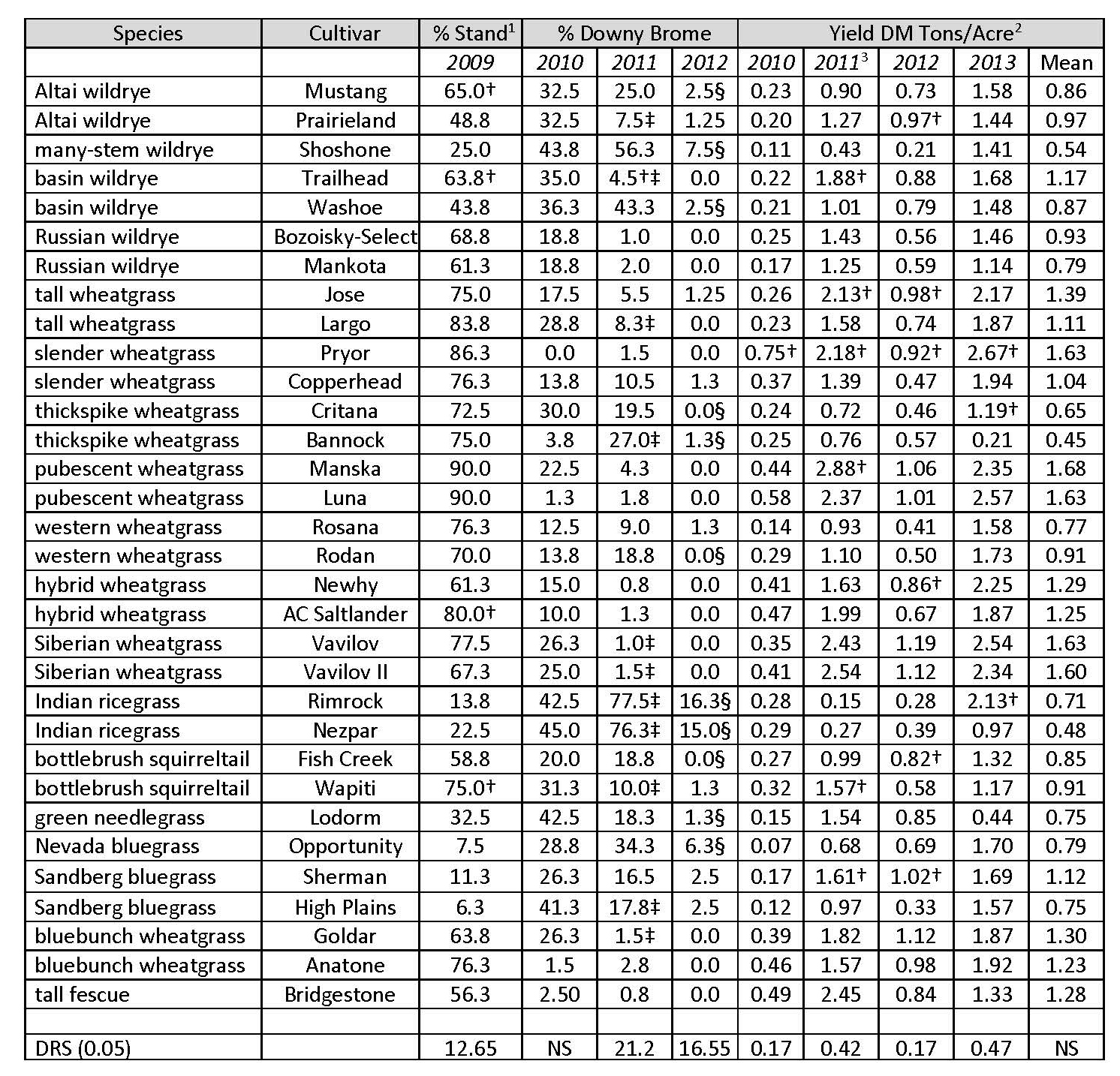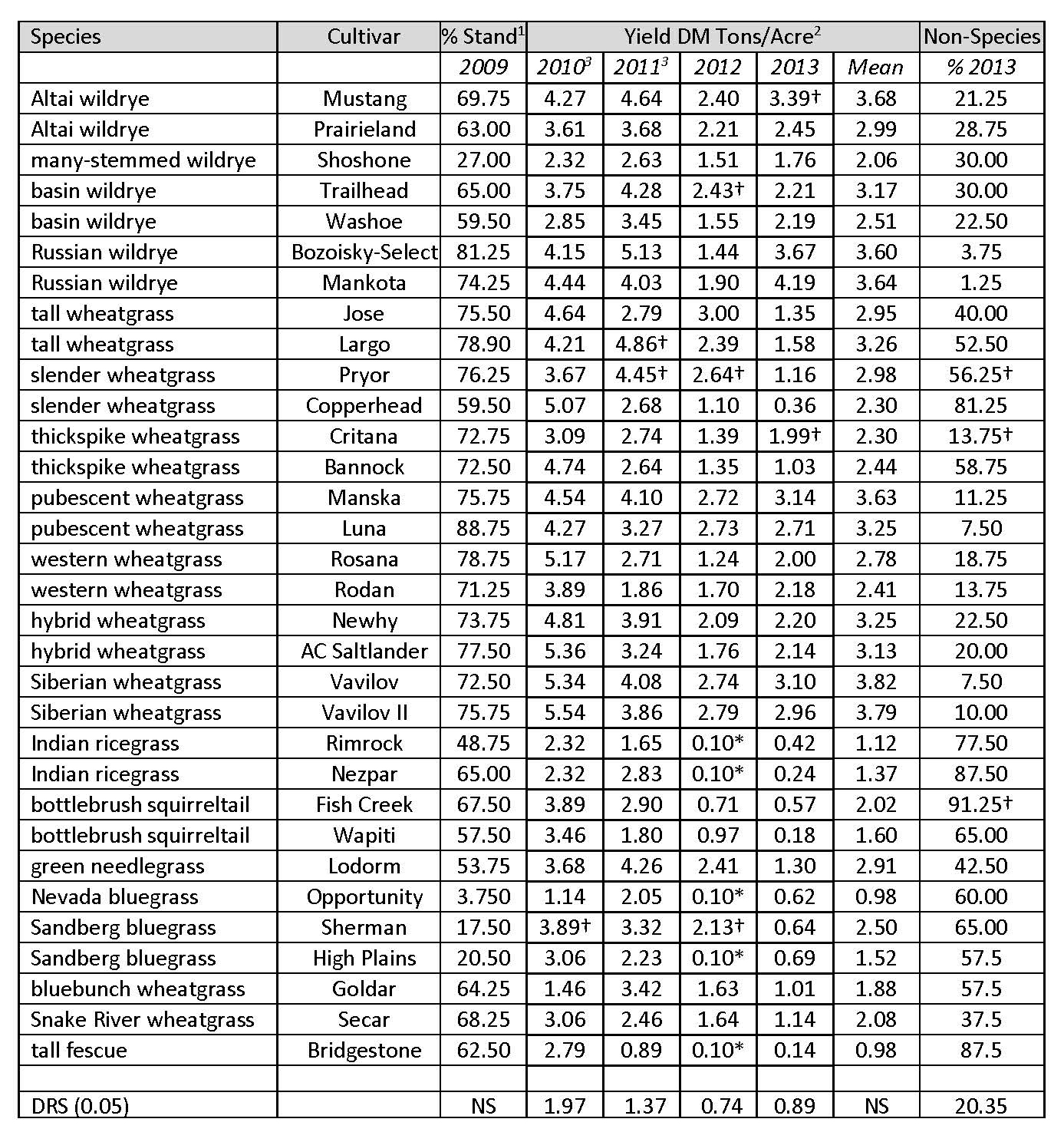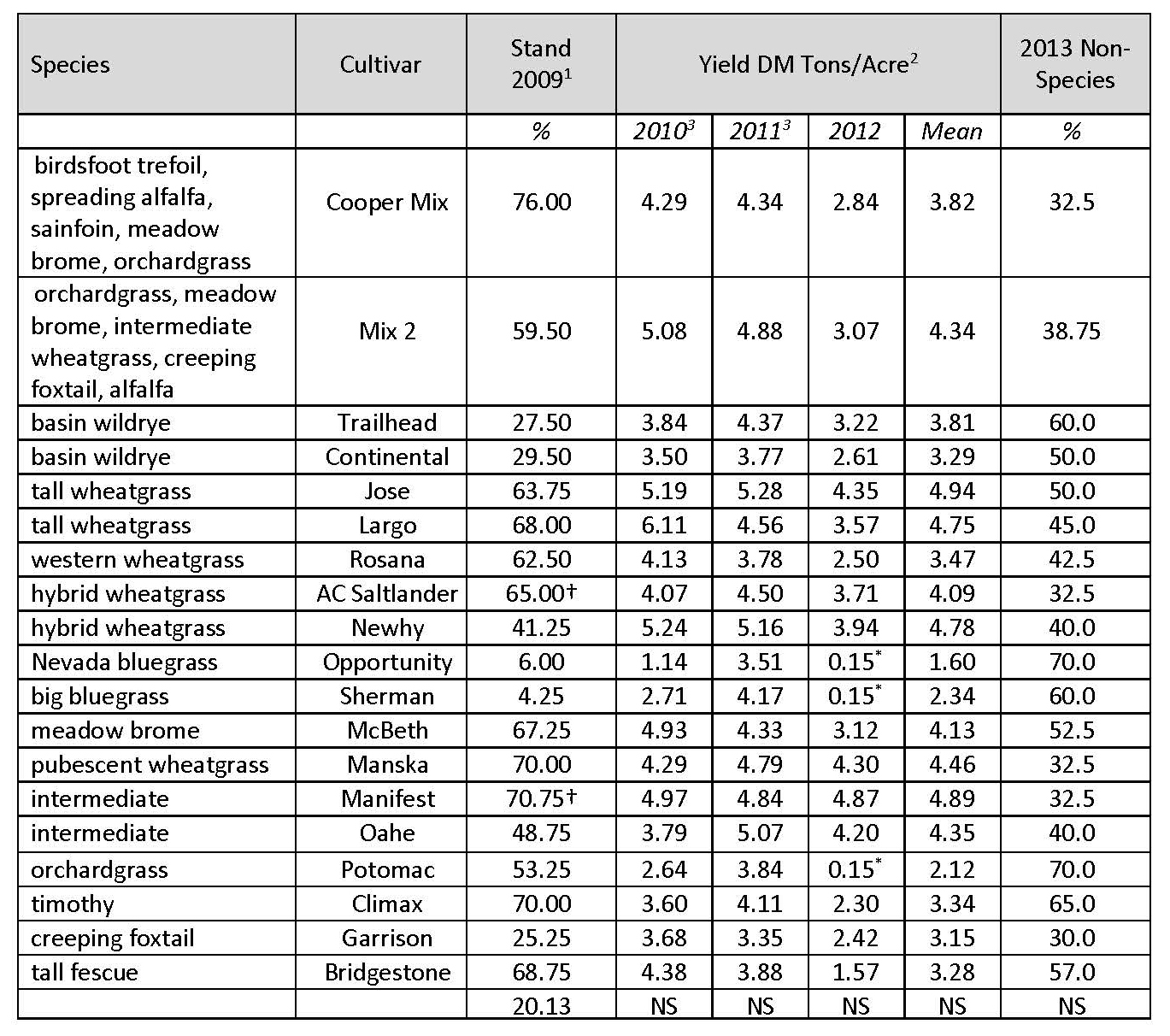Dryland and Irrigated Perennial Forage Research at NARC
by Dr. Emily Meccage, Extension Forage Specialist, Montana State University
Pasture is an important part of livestock production in Montana, and can provide most of the required nutrients of the grazing animal. Important in providing nutrients, is establishing and maintaining a quality pasture, that has the ability to perform to your expectations, and fit your production goals. Integral in achieving this is choosing the proper forage species for your pasture. While native grasses are an excellent forage source, introduced or improved grass cultivars often show improved yield and quality over the native grass species.
A study was conducted with replicated sites at NARC (Havre, MT), and CARC (Moccasin, MT) to investigate the establishment of 32 cool season grasses, as well as some forage mixtures. At the NARC location, trial 1 investigated establishment of 32 cool season grasses in a dryland trial, while trial 2 was an irrigated trial which consisted of 13 cool season grasses and 2 grass/ legume mixtures. At the CARC location, trial 1 consisted of the same 32 grasses in a dryland setting, with trial 2 being an alternate row mixture trial, with a mixture of Shaw alfalfa and each of the 13 cool season grass species.
The results of the study illustrate the need for effective planning in your pasture management program. Important in deciding which species to plant is evaluation of: 1) local average precipitation amounts, 2) current location productivity (i.e. weedy pressure), and 3) production goals.
In trial 1 (Tables 1 and 2) at both sites, there were clear performance differences amongst the various cultivars. At the NARC site, which in the establishment year had an above-average amount of rainfall (9.69” from April 1 through July 31; 144% of 95-year average), both of the varieties of Siberian wheatgrass (Vavilov and Vavilov II) had high dry matter yields, at 5.34 and 5.54 Tons DM/ acre, respectively. The hybrid wheatgrass AC Saltlander also ranked among the highest producing, at 5.36 Tons DM/ acre, with ‘Rosana’ Western Wheatgrass right behind at 5.17 Tons DM/ acre. It should be noted that this was an exceptionally wet year, and yields this high should not always be expected. When comparing the same grass species at the CARC location, which had only 5.1” during the same time period (59.7% of 100-year average), Vavilov and Vavilov II yielded .35 and .41 tons/ DM acre, Rosana yielded .14 tons DM/ acre, and AC Saltlander produced .47 tons DM/ acre. The highest yielding cultivar in this year at CARC was ‘Pryor’ slender wheatgrass, with .75 tons DM/ acre.
There were also variety differences within species, particularly dependent on rainfall amounts. For instance, similar to results found in Idaho and Washington, ‘Anatone’ bluebunch wheatgrass is recommended for sites of 10” of precipitation, while ‘Goldar’ bluebunch wheatgrass is recommended for areas with at least 12” of precipitation.
Differences were also observed amongst species in absence or presence of weeds. At CARC, Indian ricegrass had significant amounts of cheatgrass present in the plots. In all forage species, there was a general decline in the percent of cheatgrass from the first year of sampling (2010) to 2012. At the NARC location, the grasses with the highest percent of weeds were: Nevada bluegrass (70% weeds), orchardgrass (65% weeds), and big bluegrass (60% weeds). Those species with the lowest percent of weeds were: creeping foxtail (30%), pubescent wheatgrass (32.5%), intermediate wheatgrass (32.5%), and green wheatgrass (32.5%).
In the CARC Trial 2 (Table 3), there were significant differences in forage yields. The plots containing Shaw alfalfa and ‘Trailhead’ basin wildrye produced 0.89 tons DM/ acre, while the plots with Shaw alfalfa and ‘AC Saltlander’ green wheatgrass produced 3.20 tons DM/ acre in 2010. The mixture containing ‘AC Saltlander’ continued to outperform the other mixtures through the next two years of sampling. There was also a trend observed that the rhizomatous species had higher stand percentages when compared to the bunchgrasses. The exception to this was altai wildrye, which was slower to establish.
Spacing also played a significant role in forage yields for some of the species. The Russian wildrye was negatively impacted by a narrow 14” row spacing, decreasing its potential yield. Russian wildrye prefers spacings of at least 18” between rows.
In the irrigated trial at NARC (Trial 2; Table 4), mean stand percentages ranged from 70.75% for ‘Manifest’ intermediate wheatgrass, to 4.25% for ‘Sherman’ big bluegrass. The only species which had cultivar differences within species in stand percentages were ‘AC Saltlander’ green wheatgrass over ‘Newhy’ and ‘Manifest’ intermediate wheatgrass over ‘Oahe’. The “Mix 2” had greater regrowth for second cutting compared to the “Cooper Mix”. Hot, dry conditions led to decreased production in several of the cool season cultivars. The forage species that had the highest yields were: ‘Jose’ tall wheatgrass, ‘Manifest’ intermediate wheatgrass, ‘Newhy’ hybrid wheatgrass, and ‘Largo’ tall wheatgrass at 4.94, 4.89, 4.78, and 4.75 tons/ acre, respectively.
In the same trial, plots with the mixed species had the lowest number of non-species in 2013, as well as having some of the highest stand establishment rates. Yields were also ranked among the highest of all plantings, with “Mix 2” (consisting of orchardgrass, meadow brome, intermediate wheatgrass, creeping foxtail, and alfalfa) only lagging behind monocultures of ‘Jose’ tall wheatgrass, ‘Largo’ tall wheatgrass, and ‘Newhy’ hybrid wheatgrass in 2010. It was still among the highest yielding in 2011, however, the yields did fall in the middle in 2012, with only one harvest produced that year.
There are many variables to consider when establishing a perennial pasture. This study illustrates the importance of some of these, such as precipitation, weed pressure, and even planter spacing. In order to establish productive pastures, we have to tailor our seedings, and seed mixes, to best fit our environment and production needs.
Table 1. Percent downy brome and cool season dryland forage yields from 2010-2013, MSU-CARC, Moccasin, MT.

Table 2. Dryland cool season forage yields from 2010 to 2013 at MSU-NARC, Ft. Assiniboine, MT.

Table 3. Alternate row Shaw alfalfa/grass dryland forage yields at MSU-CARC, 2010–2012, Moccasin, MT.

Table 4. Irrigated cool season grass stand percentages and forage yields from 2010 to 2012 and percent non-species present in 2013 at MSU-NARC, Ft. Assiniboine, MT.

